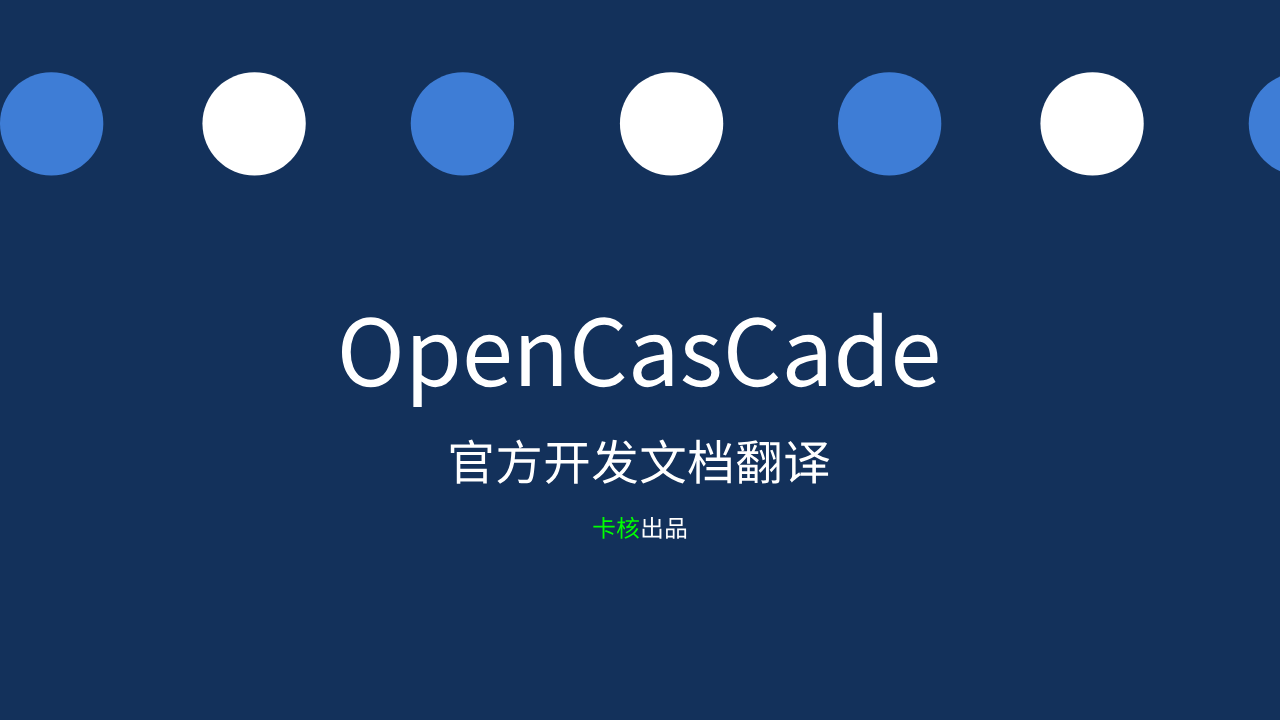总目录 >> PythonOCC入门进阶到实战(目前已更新入门篇、基础篇和进阶篇)
如果你有什么不懂,欢迎加入pythonocc中文社区:860536842
工作招募,一起来实现国产云端CAD—> 几何算法开发工程师(三维CAD)
在线文档: https://docs.qq.com/doc/Bn4shC4LUrL94tF82G4A4mik3hICVM0QiLYO3IQmKC2Cjyb924XTsd1cMhD11MsYQr3XBTqn1
pythonocc 常见问题集锦
你在使用过程中可能面临着各种各样的问题,此部分的问题,一是来源于我自己遇到的和网友询问我的,二是从pythonocc社区上搬运过来的(因为那里是全英文,很多人可能看不懂,我会尽力去翻译),我会尽量更新最新版
- 问题1. Issue on OCC.IFSelect module(cityofstaaars commented on 11 Aug)
OCC.IFSelect 的问题(2018.8.11由cityofstaaars 提出)
hello.
你好
I’d like to know what function is available if I import IFSelect_RetDone and IFSelect_ItemsByEntity class from OCC.IFSelect module.
我想知道如果我从OCC.IFSelect模块中导入IFSelect_RetDone和IFSelect_ItemsByEntity函数 会得到什么功能?
There is no description about those classes in module index page of pythonocc.org .
在pythonocc官方主页中没有相关描述
thank you
解答:See the official opencascade documentation https://www.opencascade.com/doc/occt-6.9.0/refman/html/_i_f_select___return_status_8hxx.html and https://www.opencascade.com/doc/occt-6.9.1/refman/html/_i_f_select___print_count_8hxx.html
去看官方opencascade文档,链接如上
- 问题2.how to detect the RGB value of the face
如何获得面的RGB值?(2018.7.16)
sir,
I’ve trying to detect the RGB value in my project. I used AIS_ColoredShape class to color different faces and now i wanna detect the color of clicked face.
先生,在我的项目里,我想去测试我的RGB值,我使用了AIS_ColoredShape模块给面上了不同的色,现在我想获取 被点击的面的颜色
So if you know any method to do the same please help me out. I’m an under graduate and is beginner in OCC please respond.
因此如果你知道任何解决这个问题的方法请帮助我,我是一个毕业生,同时也是OCC的入门者,请回复,谢谢你了
THANK YOU!!
解答:Just use the Color() method inherited from AIS_InteractiveObject
使用 AIS_InteractiveObject的Color()函数
- 问题3.How to calculate the point of intersection with line and surface?
如何计算线和面的交点?(2018.4.19)
I want to calculate the point of intersection with line and surface.
我想去计算线和面的交点
Line is given by a point and direction.
线是通过一个点和一个方向来绘制的
Surface is given by the location and surface data.
面是通过位置和面的信息构成的
If the surface is plane (no curvature), I can calculate the point of intersection by IntAna_IntConicQuad. But, this method can’t be applied for curved surface.
如果这个面是平面(没有曲率),我能通过IntAna_IntConicQuad来计算出交点。但是,这个方法不适用于曲面
In addition, I want to the normal vector at the point of intersection on the surface.
此外,我想知道 点在该面上的法向量
import sys, time, os
import random
from OCC.Display.SimpleGui import init_display
from OCC.gp import gp_Pnt, gp_Ax1, gp_Ax2, gp_Ax3, gp_Vec, gp_Dir
from OCC.gp import gp_Pln, gp_Lin, gp_Translation, gp_Trsf
from OCC.Geom import Geom_Plane, Geom_Surface, Geom_BSplineSurface
from OCC.Geom import Geom_Curve, Geom_Line
from OCC.GeomAPI import GeomAPI_PointsToBSplineSurface
from OCC.GeomAbs import GeomAbs_C0, GeomAbs_C1, GeomAbs_G1, GeomAbs_G2
from OCC.GeomLProp import GeomLProp_SurfaceTool
from OCC.TColgp import TColgp_Array1OfPnt, TColgp_Array2OfPnt
from OCC.TColStd import TColStd_Array1OfReal, TColStd_Array1OfInteger
from OCC.TopLoc import TopLoc_Location
from OCC.TopoDS import TopoDS_Vertex, TopoDS_Builder, TopoDS_Face
from OCC.BRepBuilderAPI import BRepBuilderAPI_MakeFace
from OCC.BRep import BRep_Tool
from OCCUtils.Construct import make_plane, make_line, make_edge, make_vertex
from OCCUtils.Construct import dir_to_vec, vec_to_dir
from OCCUtils.Common import project_point_on_plane
def make_face(px, py, pz):
nx, ny = px.shape
print (px.shape, pz.shape)
pnt_2d = TColgp_Array2OfPnt(1, nx, 1, ny)
print (pnt_2d.LowerRow(), pnt_2d.UpperRow())
print (pnt_2d.LowerCol(), pnt_2d.UpperCol())
for row in range (pnt_2d.LowerRow(), pnt_2d.UpperRow()+1):
for col in range (pnt_2d.LowerCol(), pnt_2d.UpperCol()+1):
i,j = row-1, col-1
pnt = gp_Pnt (px[i, j], py[i, j], pz[i, j])
pnt_2d.SetValue(row, col, pnt)
#print (row, col, i, j, px[i, j], py[i, j], pz[i, j])
curve = GeomAPI_PointsToBSplineSurface(pnt_2d, 3, 8, GeomAbs_G2, 0.001).Surface()
return curve
if __name__ == '__main__':
lxy = [-100, -100, 100, 100]
nxy = [300, 400]
px = np.linspace (lxy[0], lxy[2], nxy[0])
py = np.linspace (lxy[1], lxy[3], nxy[1])
print (px[0], px[-1], px.shape)
print (py[0], py[-1], py.shape)
mesh = np.meshgrid (px, py)
surf = mesh[0]**2/500 + mesh[1]**2/600 + mesh[0]*mesh[1]/20000 # arbitrary function or data
spl_geom = make_face (*mesh, surf)
spl_objt = spl_geom.GetObject()
spl_face = BRepBuilderAPI_MakeFace(spl_geom, 0, 1, 0, 1, 0.001).Face()
ax0 = gp_Ax3()
ax1 = gp_Ax3(gp_Pnt(0, 0, 100), gp_Dir(0, 0.1, 1))
trf_face = gp_Trsf ()
trf_face.SetTransformation(ax1, ax0)
loc_face = TopLoc_Location (trf_face)
spl_face.Location(loc_face)
spl_surf = BRep_Tool.Surface(spl_face)
print (spl_geom, spl_objt)
print (spl_face, spl_surf)
p00, p01 = gp_Pnt(), gp_Pnt()
p10, p11 = gp_Pnt(), gp_Pnt()
pu, pv = random.uniform(0,1), random.uniform(0,1)
pnt = gp_Pnt()
ray = Geom_Line (gp_Lin (pnt, gp_Dir(0, -0.1, 1)))
GeomLProp_SurfaceTool.Value (spl_surf, 0.0, 0.0, p00)
GeomLProp_SurfaceTool.Value (spl_surf, 0.0, 1.0, p01)
GeomLProp_SurfaceTool.Value (spl_surf, 1.0, 0.0, p10)
GeomLProp_SurfaceTool.Value (spl_surf, 1.0, 1.0, p11)
GeomLProp_SurfaceTool.Value (spl_surf, pu , pv , pnt)
print (p00)
print (p01)
print (p10)
print (p11)
print (pu, pv, pnt)
display, start_display, add_menu, add_function_to_menu = init_display()
display.DisplayShape (spl_face)
display.DisplayShape (gp_Pnt())
display.DisplayShape (ray)
display.FitAll()
start_display()
解答:Try GeomAPI_IntCS.
试一试GeomAPI_IntCS模块
Then, use the method GeomAPI_IntCS::Parameters to get the (u,v) parameters on the surface. Evaluate the u- and v-direction first derivatives at that point and then take the cross product to get the normal.
使用这个方法(GeomAPI_IntCS),你就可以获得面的uv参数信息,评估u向和v向,在该点 微分,然后叉乘(注:一种数学运算)获取法向信息。
import numpy as np
import sys, time, os
import random
from OCC.Display.SimpleGui import init_display
from OCC.gp import gp_Pnt, gp_Ax1, gp_Ax2, gp_Ax3, gp_Vec, gp_Dir
from OCC.gp import gp_Pln, gp_Lin, gp_Translation, gp_Trsf
from OCC.Geom import Geom_Plane, Geom_Surface, Geom_BSplineSurface
from OCC.Geom import Geom_Curve, Geom_Line
from OCC.GeomAPI import GeomAPI_PointsToBSplineSurface, GeomAPI_IntCS
from OCC.GeomAbs import GeomAbs_C0, GeomAbs_C1, GeomAbs_G1, GeomAbs_G2
from OCC.GeomLProp import GeomLProp_SurfaceTool
from OCC.TColgp import TColgp_Array1OfPnt, TColgp_Array2OfPnt
from OCC.TColStd import TColStd_Array1OfReal, TColStd_Array1OfInteger
from OCC.TopLoc import TopLoc_Location
from OCC.TopoDS import TopoDS_Vertex, TopoDS_Builder, TopoDS_Face
from OCC.BRepBuilderAPI import BRepBuilderAPI_MakeFace
from OCC.BRep import BRep_Tool
from OCCUtils.Construct import make_plane, make_line, make_edge, make_vertex
from OCCUtils.Construct import dir_to_vec, vec_to_dir
from OCCUtils.Common import project_point_on_plane
def make_face(px, py, pz):
nx, ny = px.shape
print (px.shape, pz.shape)
pnt_2d = TColgp_Array2OfPnt(1, nx, 1, ny)
print (pnt_2d.LowerRow(), pnt_2d.UpperRow())
print (pnt_2d.LowerCol(), pnt_2d.UpperCol())
for row in range (pnt_2d.LowerRow(), pnt_2d.UpperRow()+1):
for col in range (pnt_2d.LowerCol(), pnt_2d.UpperCol()+1):
i,j = row-1, col-1
pnt = gp_Pnt (px[i, j], py[i, j], pz[i, j])
pnt_2d.SetValue(row, col, pnt)
#print (row, col, i, j, px[i, j], py[i, j], pz[i, j])
curve = GeomAPI_PointsToBSplineSurface(pnt_2d, 3, 8, GeomAbs_G2, 0.001).Surface()
return curve
def reflection (h_surf, pnt, vec):
ray = Geom_Line (gp_Lin (pnt, vec_to_dir(vec.Normalized())))
uvw = GeomAPI_IntCS (ray.GetHandle(), h_surf).Parameters(1)
u, v, w = uvw
p, vx, vy = gp_Pnt(), gp_Vec(), gp_Vec()
GeomLProp_SurfaceTool.D1 (h_surf, u, v, p, vx, vy)
vz = vx.Crossed(vy)
vx.Normalize()
vy.Normalize()
vz.Normalize()
v = v0.Mirrored(gp_Ax2(pnt, vec_to_dir(vz)))
return p, v
if __name__ == '__main__':
lxy = [-100, -100, 100, 100]
nxy = [300, 400]
px = np.linspace (lxy[0], lxy[2], nxy[0])
py = np.linspace (lxy[1], lxy[3], nxy[1])
print (px[0], px[-1], px.shape)
print (py[0], py[-1], py.shape)
mesh = np.meshgrid (px, py)
surf = mesh[0]**2/500 + mesh[1]**2/600 + mesh[0]*mesh[1]/20000 # arbitrary function or data
spl_geom = make_face (*mesh, surf)
spl_objt = spl_geom.GetObject()
spl_face = BRepBuilderAPI_MakeFace(spl_geom, 0, 1, 0, 1, 0.001).Face()
ax0 = gp_Ax3()
ax1 = gp_Ax3(gp_Pnt(0, 0, 100), gp_Dir(0, 0, 1))
trf_face = gp_Trsf ()
trf_face.SetTransformation(ax1, ax0)
loc_face = TopLoc_Location (trf_face)
spl_face.Location(loc_face)
spl_surf = BRep_Tool.Surface(spl_face)
print (spl_geom, spl_objt)
print (spl_face, spl_surf)
p0, v0 = gp_Pnt(), gp_Vec(0, -0.1, 1.0).Normalized()
p1, v1 = reflection (spl_surf, p0, v0)
p2 = gp_Pnt((gp_Vec(p1.XYZ()) + v1*50).XYZ())
ray01 = make_edge (p0, p1)
ray12 = make_edge (p1, p2)
display, start_display, add_menu, add_function_to_menu = init_display()
display.DisplayShape (spl_face)
display.DisplayVector (v0*10, p0)
display.DisplayVector (v1*10, p1)
display.DisplayShape (ray01)
display.DisplayShape (ray12)
display.FitAll()
start_display()
















